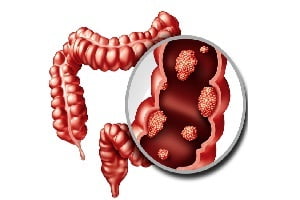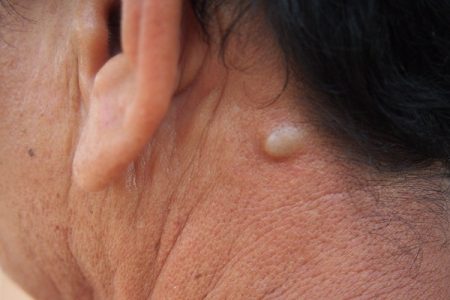A lump under the chin is a swollen area, also known as a bump, appears under the chin, either along the jaw line or on the front part of the neck. It may appear as a single bump or more than one lump in a cluster. These lumps under the chin are usually harmless.
Hard Lump Under Chin that Hurts to Touch – Can It Be cancer?
A lump under the chin usually appears as a boil or abscess. On touch, it may feel soft or hard. Generally, a lump under the chin does not cause pain, while in some cases, it may be tender and painful to touch. When these lumps do not cause any pain, they can be present for a long time before you notice them.
These lumps are usually harmless, but some need medical attention to cease any further complications. Swollen lymph nodes cause a lump under the chin. A typical infection may trigger this swelling. Other causes of a lump under the chin may include cancer, cysts, abscesses, benign tumors, or cancers, and other medical issues. However, these causes are much rarer in comparison to infection.
The lump’s symptoms, size, and shape will likely differ depending on the cause of a lump under the chin.
What Causes a Lump Under Chin?
Chin lumps can be a result of various medical conditions. Below are some common causes of a lump under the chin.
Infection
A lump under the chin can be formed as a result of both bacterial and viral infections. Lumps are generally swollen lymph nodes.
Lymph nodes are part of your immune system’s network located throughout your body that helps protect your body from illnesses. Lymph nodes are found as round or bean-shaped organ-like structures and are small in size and flexible. You can only feel these lymph nodes close to the skin’s surface, nodes in the armpits, or close to the chin.
It’s common for lymph nodes to swell when there is an illness in your body. Sometimes they may feel tender or painful to the touch or causes discomfort when you chew or turn your head in a particular direction.
If swollen lymph nodes cause a lump under the chin, the lump should disappear as the infection clears up. You may need to visit the doctor for infection treatment or the underlying cause of swollen lymph nodes.
The following infections can trigger the swelling of lymph nodes:
- Respiratory infections such as colds and the flu
- Strep throat
- Measles
- Ear infections
- Mononucleosis (mono)
- Sinus infections
- Syphilis or Lyme disease
- HIV or AIDS
- An infected (abscess) tooth or any mouth infection
- Skin infections, such as cellulitis
- Some other medical conditions may also cause lymph nodes to swell, such as tuberculosis and immune system disorders.
If a swollen lymph node causes the lump under chin, you may also experience other symptoms, such as:
- Fever
- Chills or night sweats
- Fatigue
- Swelling of other lymph nodes, such as in the groin or under the arms
- Infections of the upper respiratory tract such as cough sore throat, runny nose, etc.
Read Neck Lumps and Bumps: What Do They Mean?
Types
Epidermoid cyst
Epidermoid cysts are rounded nodules that form beneath the skin, often resulting from skin cells that migrate beneath the skin surface instead of being shed. These cysts can also originate from damaged hair follicles or an accumulation of the protein, keratin. Characteristics of epidermoid cysts include:
- Gradual growth
- Persistence, often lasting years
- Possible presence of a central blackhead
- Potential to exude a yellowish, malodorous discharge, typically keratin
- Generally asymptomatic, though they can become inflamed and sore if infected Research indicates that males are twice as likely to develop these cysts, which seldom appear before puberty.
Lipoma
Lipomas represent benign adipose tissue proliferations that manifest as subcutaneous nodules. While their etiology remains ambiguous, physical traumas have been postulated as potential triggers. The presence of multiple lipomas might be indicative of genetic disorders, such as Gardner’s syndrome. Demographically, lipomas are predominantly observed in individuals aged between 40 and 60 years. Their clinical characteristics include:
- Typically asymptomatic presentation
- Gradual growth kinetics
- A palpably soft, rubbery consistency
- Potential mobility upon palpation
These formations can emerge anywhere on the body, with a higher prevalence on the shoulders, neck, torso, and axillary regions. Further investigation into the symptomatology and etiological factors of lipomas is warranted.
Dermatofibroma
Dermatofibromas are benign subcutaneous nodules, often presenting as small, firm bumps on the skin. While typically asymptomatic, these nodules can occasionally manifest with itching or discomfort. The precise etiology is nebulous, but anecdotal evidence suggests potential links to minor skin traumas like splinters or insect bites in the affected areas. Characteristics of dermatofibromas include:
- Color variations from dark pink to brown or black, contingent on an individual’s skin hue
- A palpably firm and rubbery texture
- A higher incidence in females, as per scientific studies
- Generally not exceeding a diameter of 1 cm
- Slow growth kinetics
Though they can materialize on any part of the body, dermatofibromas predominantly manifest on the lower legs and upper arms.
Cancer
A lump under the chin can also be caused by cancer. Though it can appear at any age, it is more likely to affect older adults. There are various ways through which cancer can cause a lump to form under the chin. A lump can form when:
- Organs such as the mouth, throat, thyroid, or salivary gland are being affected by the cancer
- Metastatic cancer from a distant organ has spread to the lymph nodes under the chin
- Cancer is of the lymphatic system itself
- Cancer of skin appears under the chin
- Sarcoma develops under the chin
Some cancers cause swelling of lymph nodes, specifically such as leukemia and Hodgkin’s disease.
A lump caused by cancer usually feels hard and is not tender or painful to the touch. Other symptoms of a cancerous lump are the following:
- Unexplained weight loss
- Indigestion
- Change in voice or hoarseness
- Difficulty swallowing or breathing
- Lumps elsewhere in the body
- Feeling of a lump in the throat persistently
- Change in the shape and size of the lump
- Persistently weakened immune system
- Recurring infections
- Growths that discharge pus or blood
Suppose a cancerous tumor causes your lump under the chin. In that case, you will be directed to cancer treatment, and your doctor might suggest chemotherapy, radiation, or surgery to remove the lump.
Benign Tumours and Cysts
Other growths such as cysts and benign tumours are non-cancerous. Cysts are fluid-filled sac-like structures, while benign tumours form when your cells start to divide at an abnormal rate. Benign tumours are unable to invade the neighbouring tissues or spread to other parts of the body. Cysts and benign tumours which may cause a lump to develop under your chin include:
- Lipomas
- Fibromas
- Epidermoid (sebaceous) cysts
Lipomas, fibromas, and epidermoid cysts can be either soft or firm and usually are not painful. They may cause discomfort when they grow in size and put pressure on nearby structures.
Other Possible Causes of a Lump Under Chin
Lump under the chin may be formed due to a range of factors, including the following:
- Salivary duct stones
- Acne
- Boils
- Tonsillitis
- Food allergies
- Goiters
- Any injury
- Hematoma
- A bug bite or insect stings
- Broken bones
- A fractured jaw
- Certain medications
- Damage to sebaceous glands in the chin
When Should You Contact a Doctor?
A lump under the chin should resolve on its own. Treating the underlying cause will relieve the swelling and lump. You should seek medical attention if:
- You have an unexplained lump under chin.
- The lump under your chin is growing in its size.
- Your lump has been present for two or more weeks.
- The lump under the chin feels hard or doesn’t move, even when pushed on.
- The lump under the chin is accompanied by unexplained symptoms like weight loss, fever, or night sweats
You should consult your doctor on an emergency basis if you have a lump under the chin and are feeling difficulty breathing and swallowing.
FAQs
Why do I have lump under my chin?
A bacterial or viral infection is the most common cause of a lump under your chin or in your neck. These lumps, known as reactive lymph nodes, usually indicate that your immune system is fighting an infection. Colds, the flu, sinus and ear infections, tooth or gum infections, and strep throat are all common infections. A reactive lymph node feels squishy to the touch, moves around in your neck, and is frequently painful. They usually go away when the infection is treated or stops.
Will the lump under my chin go away on its own?
It all depends. If your chin lump is caused by abnormal cell growth, it may remain stable, grow, or shrink. If it is caused by an infection, it may resolve on its own as your body fights the infection or it may resolve with over-the-counter anti-inflammatory medication such as Advil or Motrin. If the infection has caused a collection of pus (an abscess), it may go away on its own, but it usually requires draining by a medical professional. A medical provider should be consulted if a lump persists or grows over time.
Is my sore chin lump serious?
A minor chin lump that resolves on its own is usually not dangerous. A medical provider should be consulted if a jaw lump persists for two weeks or more. A large chin lump associated with redness or pain that does not seem to be going away should be evaluated by a medical professional, especially if you also have a fever. Jaw lumps that are growing and/or feel fixed in place may be a sign of cancer, especially if they are accompanied by unexplained weight loss, fever, or night sweats, and should be seen by a doctor as soon as possible.
Is there a link between a lump under the chin and cancer?
If cancer affects a nearby area, such as the mouth, throat, sinuses, thyroid, or salivary glands, it can cause swelling. A lump in the neck could be a metastasis of cancer from another organ to the lymph nodes in the neck, or it could be primary cancer of the lymph nodes (lymphoma). Cancerous lumps are typically hard to the touch but not painful.
Can a lump under my chin indicate cancer elsewhere in my body?
A chin lump caused by an enlarged lymph node can sometimes be a sign of cancer in another part of the body. Most commonly, cancerous lymph nodes under or along the jaw indicate head and neck cancer. Cancers of the head and neck most commonly begin in the oral cavity (including the tongue, hard palate, cheek, and gums), throat (including the tonsils, base of tongue, and soft palate), and larynx (voice box). Tobacco or alcohol use is commonly associated with head and neck cancer.
When should I worry about a mass under my chin?
You should be concerned about a mass under your chin if it persists for more than two weeks, grows in size, is painful, or is accompanied by other symptoms such as fever, fatigue, or unexplained weight loss.
What does a cancer lump feel like under the chin?
A cancer lump under the chin may feel hard and immovable. It may be painless or cause discomfort, depending on its size and location. However, it is important to note that not all lumps under the chin are cancerous, and a proper diagnosis from a healthcare professional is necessary to determine the cause.






